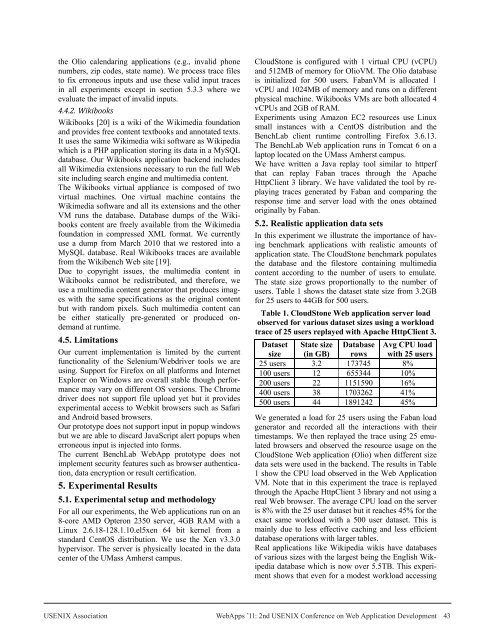2nd USENIX Conference on Web Application Development ...
2nd USENIX Conference on Web Application Development ...
2nd USENIX Conference on Web Application Development ...
Create successful ePaper yourself
Turn your PDF publications into a flip-book with our unique Google optimized e-Paper software.
the Olio calendaring applicati<strong>on</strong>s (e.g., invalid ph<strong>on</strong>e<br />
numbers, zip codes, state name). We process trace files<br />
to fix err<strong>on</strong>eous inputs and use these valid input traces<br />
in all experiments except in secti<strong>on</strong> 5.3.3 where we<br />
evaluate the impact of invalid inputs.<br />
4.4.2. Wikibooks<br />
Wikibooks [20] is a wiki of the Wikimedia foundati<strong>on</strong><br />
and provides free c<strong>on</strong>tent textbooks and annotated texts.<br />
It uses the same Wikimedia wiki software as Wikipedia<br />
which is a PHP applicati<strong>on</strong> storing its data in a MySQL<br />
database. Our Wikibooks applicati<strong>on</strong> backend includes<br />
all Wikimedia extensi<strong>on</strong>s necessary to run the full <strong>Web</strong><br />
site including search engine and multimedia c<strong>on</strong>tent.<br />
The Wikibooks virtual appliance is composed of two<br />
virtual machines. One virtual machine c<strong>on</strong>tains the<br />
Wikimedia software and all its extensi<strong>on</strong>s and the other<br />
VM runs the database. Database dumps of the Wikibooks<br />
c<strong>on</strong>tent are freely available from the Wikimedia<br />
foundati<strong>on</strong> in compressed XML format. We currently<br />
use a dump from March 2010 that we restored into a<br />
MySQL database. Real Wikibooks traces are available<br />
from the Wikibench <strong>Web</strong> site [19].<br />
Due to copyright issues, the multimedia c<strong>on</strong>tent in<br />
Wikibooks cannot be redistributed, and therefore, we<br />
use a multimedia c<strong>on</strong>tent generator that produces images<br />
with the same specificati<strong>on</strong>s as the original c<strong>on</strong>tent<br />
but with random pixels. Such multimedia c<strong>on</strong>tent can<br />
be either statically pre-generated or produced <strong>on</strong>demand<br />
at runtime.<br />
4.5. Limitati<strong>on</strong>s<br />
Our current implementati<strong>on</strong> is limited by the current<br />
functi<strong>on</strong>ality of the Selenium/<strong>Web</strong>driver tools we are<br />
using. Support for Firefox <strong>on</strong> all platforms and Internet<br />
Explorer <strong>on</strong> Windows are overall stable though performance<br />
may vary <strong>on</strong> different OS versi<strong>on</strong>s. The Chrome<br />
driver does not support file upload yet but it provides<br />
experimental access to <strong>Web</strong>kit browsers such as Safari<br />
and Android based browsers.<br />
Our prototype does not support input in popup windows<br />
but we are able to discard JavaScript alert popups when<br />
err<strong>on</strong>eous input is injected into forms.<br />
The current BenchLab <strong>Web</strong>App prototype does not<br />
implement security features such as browser authenticati<strong>on</strong>,<br />
data encrypti<strong>on</strong> or result certificati<strong>on</strong>.<br />
5. Experimental Results<br />
5.1. Experimental setup and methodology<br />
For all our experiments, the <strong>Web</strong> applicati<strong>on</strong>s run <strong>on</strong> an<br />
8-core AMD Opter<strong>on</strong> 2350 server, 4GB RAM with a<br />
Linux 2.6.18-128.1.10.el5xen 64 bit kernel from a<br />
standard CentOS distributi<strong>on</strong>. We use the Xen v3.3.0<br />
hypervisor. The server is physically located in the data<br />
center of the UMass Amherst campus.<br />
CloudSt<strong>on</strong>e is c<strong>on</strong>figured with 1 virtual CPU (vCPU)<br />
and 512MB of memory for OlioVM. The Olio database<br />
is initialized for 500 users. FabanVM is allocated 1<br />
vCPU and 1024MB of memory and runs <strong>on</strong> a different<br />
physical machine. Wikibooks VMs are both allocated 4<br />
vCPUs and 2GB of RAM.<br />
Experiments using Amaz<strong>on</strong> EC2 resources use Linux<br />
small instances with a CentOS distributi<strong>on</strong> and the<br />
BenchLab client runtime c<strong>on</strong>trolling Firefox 3.6.13.<br />
The BenchLab <strong>Web</strong> applicati<strong>on</strong> runs in Tomcat 6 <strong>on</strong> a<br />
laptop located <strong>on</strong> the UMass Amherst campus.<br />
We have written a Java replay tool similar to httperf<br />
that can replay Faban traces through the Apache<br />
HttpClient 3 library. We have validated the tool by replaying<br />
traces generated by Faban and comparing the<br />
resp<strong>on</strong>se time and server load with the <strong>on</strong>es obtained<br />
originally by Faban.<br />
5.2. Realistic applicati<strong>on</strong> data sets<br />
In this experiment we illustrate the importance of having<br />
benchmark applicati<strong>on</strong>s with realistic amounts of<br />
applicati<strong>on</strong> state. The CloudSt<strong>on</strong>e benchmark populates<br />
the database and the filestore c<strong>on</strong>taining multimedia<br />
c<strong>on</strong>tent according to the number of users to emulate.<br />
The state size grows proporti<strong>on</strong>ally to the number of<br />
users. Table 1 shows the dataset state size from 3.2GB<br />
for 25 users to 44GB for 500 users.<br />
Table 1. CloudSt<strong>on</strong>e <strong>Web</strong> applicati<strong>on</strong> server load<br />
observed for various dataset sizes using a workload<br />
trace of 25 users replayed with Apache HttpClient 3.<br />
Dataset State size Database Avg CPU load<br />
size (in GB) rows with 25 users<br />
25 users 3.2 173745 8%<br />
100 users 12 655344 10%<br />
200 users 22 1151590 16%<br />
400 users 38 1703262 41%<br />
500 users 44 1891242 45%<br />
We generated a load for 25 users using the Faban load<br />
generator and recorded all the interacti<strong>on</strong>s with their<br />
timestamps. We then replayed the trace using 25 emulated<br />
browsers and observed the resource usage <strong>on</strong> the<br />
CloudSt<strong>on</strong>e <strong>Web</strong> applicati<strong>on</strong> (Olio) when different size<br />
data sets were used in the backend. The results in Table<br />
1 show the CPU load observed in the <strong>Web</strong> Applicati<strong>on</strong><br />
VM. Note that in this experiment the trace is replayed<br />
through the Apache HttpClient 3 library and not using a<br />
real <strong>Web</strong> browser. The average CPU load <strong>on</strong> the server<br />
is 8% with the 25 user dataset but it reaches 45% for the<br />
exact same workload with a 500 user dataset. This is<br />
mainly due to less effective caching and less efficient<br />
database operati<strong>on</strong>s with larger tables.<br />
Real applicati<strong>on</strong>s like Wikipedia wikis have databases<br />
of various sizes with the largest being the English Wikipedia<br />
database which is now over 5.5TB. This experiment<br />
shows that even for a modest workload accessing<br />
<str<strong>on</strong>g>USENIX</str<strong>on</strong>g> Associati<strong>on</strong> <strong>Web</strong>Apps ’11: <str<strong>on</strong>g>2nd</str<strong>on</strong>g> <str<strong>on</strong>g>USENIX</str<strong>on</strong>g> <str<strong>on</strong>g>C<strong>on</strong>ference</str<strong>on</strong>g> <strong>on</strong> <strong>Web</strong> Applicati<strong>on</strong> <strong>Development</strong> 43








